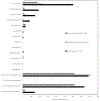A National Antimicrobial Resistance Monitoring System Survey of Antimicrobial-Resistant Foodborne Bacteria Isolated from Retail Veal in the United States
- PMID: 34015113
- PMCID: PMC11586651
- DOI: 10.4315/JFP-21-005
A National Antimicrobial Resistance Monitoring System Survey of Antimicrobial-Resistant Foodborne Bacteria Isolated from Retail Veal in the United States
Abstract
Abstract: Little is known about the prevalence of antimicrobial-resistant (AMR) bacteria in veal meat in the United States. We estimated the prevalence of bacterial contamination and AMR in various veal meats collected during the 2018 U.S. National Antimicrobial Resistance Monitoring System (NARMS) survey of retail outlets in nine states and compared the prevalence with the frequency of AMR bacteria from other cattle sources sampled for NARMS. In addition, we identified genes associated with resistance to medically important antimicrobials and gleaned other genetic details about the resistant organisms. The prevalence of Campylobacter, Salmonella, Escherichia coli, and Enterococcus in veal meats collected from grocery stores in nine states was 0% (0 of 358), 0.6% (2 of 358), 21.1% (49 of 232), and 53.5% (121 of 226), respectively, with ground veal posing the highest risk for contamination. Both Salmonella isolates were resistant to at least one antimicrobial agent as were 65.3% (32 of 49) of E. coli and 73.6% (89 of 121) of Enterococcus isolates. Individual drug and multiple drug resistance levels were significantly higher (P < 0.05) in E. coli and Enterococcus from retail veal than in dairy cattle ceca and retail ground beef samples from 2018 NARMS data. Whole genome sequencing was conducted on select E. coli and Salmonella from veal. Cephalosporin resistance (blaCMY and blaCTX-M), macrolide resistance (mph), and plasmid-mediated quinolone resistance (qnr) genes and gyrA mutations were found. We also identified heavy metal resistance genes ter, ars, mer, fieF, and gol and disinfectant resistance genes qac and emrE. An stx1a-containing E. coli was also found. Sequence types were highly varied among the nine E. coli isolates that were sequenced. Several plasmid types were identified in E. coli and Salmonella, with the majority (9 of 11) of isolates containing IncF. This study illustrates that veal meat is a carrier of AMR bacteria.
Keywords: Enterococcus; Escherichia coli; Salmonella; Antimicrobial resistance; National Antimicrobial Resistance Monitoring System; Retail veal.
Published 2021 by the International Association for Food Protection Not subject to U.S. Copyright. This is an open access article.
Figures


Similar articles
-
Antimicrobial resistance in Escherichia coli isolated from retail milk-fed veal meat from Southern Ontario, Canada.J Food Prot. 2011 Aug;74(8):1328-33. doi: 10.4315/0362-028X.JFP-10-495. J Food Prot. 2011. PMID: 21819661
-
Antimicrobial resistance in Campylobacter, Salmonella, and Escherichia coli isolated from retail grain-fed veal meat from Southern Ontario, Canada.J Food Prot. 2011 Aug;74(8):1245-51. doi: 10.4315/0362-028X.JFP-10-483. J Food Prot. 2011. PMID: 21819650
-
Whole-Genome Sequence Analysis of CTX-M Containing Escherichia coli Isolates from Retail Meats and Cattle in the United States.Microb Drug Resist. 2018 Sep;24(7):939-948. doi: 10.1089/mdr.2018.0206. Epub 2018 Aug 27. Microb Drug Resist. 2018. PMID: 30148698 Free PMC article.
-
Fluoroquinolone sales in food animals and quinolone resistance in non-typhoidal Salmonella from retail meats: United States, 2009-2018.J Glob Antimicrob Resist. 2022 Jun;29:163-167. doi: 10.1016/j.jgar.2022.03.005. Epub 2022 Mar 11. J Glob Antimicrob Resist. 2022. PMID: 35288333 Review.
-
The effect of tylosin on antimicrobial resistance in beef cattle enteric bacteria: A systematic review and meta-analysis.Prev Vet Med. 2020 Mar;176:104934. doi: 10.1016/j.prevetmed.2020.104934. Epub 2020 Feb 18. Prev Vet Med. 2020. PMID: 32109782 Free PMC article.
Cited by
-
The Impact of Antimicrobial Stewardship Training on Calf Producers' Knowledge, Treatment Behaviors and Quantified Antimicrobial Use.Microorganisms. 2022 Jul 27;10(8):1525. doi: 10.3390/microorganisms10081525. Microorganisms. 2022. PMID: 36013943 Free PMC article.
-
Quantifying antimicrobial resistance in food-producing animals in North America.Front Microbiol. 2025 May 27;16:1542472. doi: 10.3389/fmicb.2025.1542472. eCollection 2025. Front Microbiol. 2025. PMID: 40497057 Free PMC article.
-
Whole genome sequencing analysis of non-O157 Shiga toxin-producing Escherichia coli in milk in Kwara State, Nigeria.Iran J Vet Res. 2024;25(2):92-97. doi: 10.22099/IJVR.2024.49643.7307. Iran J Vet Res. 2024. PMID: 39624192 Free PMC article.
-
Genomic analysis of azithromycin-resistant Salmonella from food animals at slaughter and processing, and retail meats, 2011-2021, United States.Microbiol Spectr. 2024 Jan 11;12(1):e0348523. doi: 10.1128/spectrum.03485-23. Epub 2023 Nov 22. Microbiol Spectr. 2024. PMID: 37991374 Free PMC article.
-
Antimicrobial Use and Resistance in Surplus Dairy Calf Production Systems.Microorganisms. 2022 Aug 16;10(8):1652. doi: 10.3390/microorganisms10081652. Microorganisms. 2022. PMID: 36014070 Free PMC article. Review.
References
-
- Bielaszewska M, Mellmann A, Zhang W, Köck R, Fruth A, Bauwens A, Peters G, and Karch H. 2011. Characterisation of the Escherichia coli strain associated with an outbreak of haemolytic uraemic syndrome in Germany, 2011: a microbiological study. Lancet Infect Dis. 11:671–6. - PubMed
-
- Bosilevac JM, Zhilyaev S, Wang R, Luedtke BE, Wheeler TL, and Koohmaraie M. 2019. Prevalence and Characterization of Salmonella Present during Veal Harvest. J Food Prot. 82:775–784. - PubMed
-
- Centers for Disease Control and Prevention. 2019. Salmonella: Information for Healthcare Professional and Laboratories. Available at: https://www.cdc.gov/salmonella/general/technical.html. Accessed April 29, 2021.
MeSH terms
Substances
Grants and funding
LinkOut - more resources
Full Text Sources
Other Literature Sources
Miscellaneous

